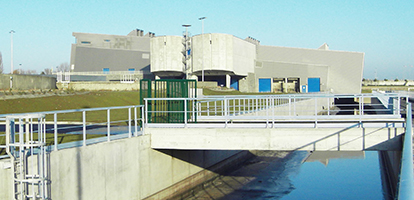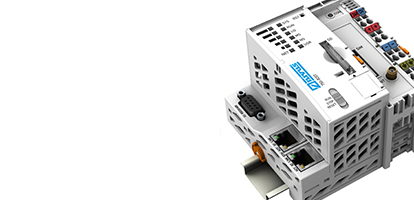


Using the right measurements – it always goes back to that when you are optimizing processes. It often sounds so easy, but it is usually anything but. Using the right measurements means: determining the data that are actually relevant for the process analysis, evaluating the data using suitable mathematical models, and bringing it into a targeted context. If this succeeds, then measures can be derived in the end that have the potential to sustainably increase the efficiency of the process. In wastewater treatment, data is primarily recorded in the sanitary sewer network or at wastewater treatment plants. NIVUS GmbH from Eppingen is among the market leaders in this sector due to their measurement sensors. Together with WAGO, the company developed a solution that links data from geographically distant stations into a network in a comparatively easy way.
Wastewater treatment facilities are sensitive systems that require constant conditions to maintain their microorganisms. In this context, a harmonized supply of wastewater is an essential prerequisite – particularly when considering the volume, concentration and composition of the waste load. This can be implemented by combining the through flow measurements from the wastewater in the sanitary sewers with hydraulic engineering systems, for example, a throttle point.
If the individual measuring stations of the hydraulic engineering systems are networked within a sewer system, then the data, that are obtained here, are available in real time at the control center of the wastewater treatment plant. By using the target-actual performance comparison of the process data from the wastewater treatment facility, the optimal supply of wastewater can be determined using mathematical calculations and the plant can be operated in the most optimal state. When calculating the necessary measures, the time delay must also be considered that exists between setting the changes, and the point when the effects of said changes are generated. Controlling the process is thus carried out long before the load arrives at the wastewater treatment plant or even its peripheral areas. At the same time, an important contribution to surface water management can be achieved by the targeted control of throttle points and other hydraulic engineering systems. In this context, NIVUS discusses an integrated process control system which forms the basis for developments in the direction of water 4.0.
Optimally Controlled Processes
Buffer storage points, for example, underground stormwater retaining basins in the sanitary sewer network for the water management area, must also be efficiently regulated. They can fill completely during heavy rain events and, as the rain tapers off, can provide a quantity of water with a low contamination load that is optimal for biological processes at the treatment facility.
For this purpose, the discharge vents of these reservoirs can be adjusted, as needed, based on the intelligent aggregated system. This is used to create harmonized purification processes that lead to good discharge values at increased energy efficiency
Standardized Solution, Complex Application
In the majority of the numerous applications used in water and wastewater treatment technology, the focus is on recurring applications. Therefore, NIVUS and WAGO developed a standardized technology. The WAGO-I/O-SYSTEM 750 with a PFC200 thereby takes on the central task of a maintenance-free IoT gateway in the substations. As the “NivuLink-Control”, it ensures the connections between sensors, actuators, and the main control center. NIVUS thus unites the automation of the centralized processing facility with the monitoring of decentrally distributed processing areas. The resulting advantages are obvious: “There is one central operational guidance down to the lowest levels. Monitoring and controlling the distributed stations is centrally carried out. The centralized visualization of system parts facilitates a fast overview and an efficient monitoring and control of distributed systems,” explains Martin Müller, Marketing Manager at NIVUS.
Easily Link in Decentralized Stations
The controllers that are decentrally installed in the aggregated system control both the process and also simultaneously monitor the system. Thus, a pump station can be both linked to and controlled at the central control panel using the PFC200, and continuous system monitoring can also be carried out. In this way, for example, signs of wear or blockages can be identified and alleviated early. With more than 500 function modules, the WAGO-I/O-SYSTEM 750 provides the hardware platform for linking various sensors, measuring technologies and also drives. This allows the process values to be recorded in a targeted way at the substations and then evaluated.
There is a good reason that Martin Müller designates the PFC200 as the “remote brain that links the compiled sensor information with the control system – and we ideally provide both the sensors and the control system.” This system solution provides an overview at all times into the the aggregated wastewater treatment facility. This reduces personnel expenses for monitoring and maintenance of the system, while increasing operational safety at the same time.
“By using process values measured at the substations, targeted conclusions can be drawn about the state of the system as a whole. ,The system solution using NICOS and the PFC200, or ‘NivuLink Control’, represents an important step towards predictive maintenance for the operators,” emphasizes Kay Miller, Global Industry Manager Water at WAGO. The general openness of the WAGO-I/O-SYSTEM 750 smooths the path for collecting highly varied analysis values, signal types or data formats using suitable I/O modules, processing the data in the controller, and then forwarding it to the control center as a bundled data packet using TCP/IP
No Limits to the Connections
In addition, the many interfaces included in the WAGO-I/O-SYSTEM 750 facilitate communication with adjacent machines and system components. Both analog and digital outputs as well as bus technologies are available for controlling actuators. The measured value memory in the device can be easily expanded using SD cards. Connections to higher-level systems can be established in the traditional way using current data lines, or wirelessly using the 3G version of the PFC200.
“By expanding the PFC200 to the ‘NivuLink Control’, NIVUS has created a solution that can be used independent of local network availability or specific SIM cards. They thus offer a choice between server-based and cloud-based applications,” explains Miller. The “NivuLink Control”, based on the PFC200, is characterized by minimal data volumes, which thus reduces costs for data transmission. Alarm and trigger functions accelerate processes in predefined scenarios. Integrated security features, like OVPN, IPsec, or TLS are used to ensure transmission security. Therefore, the “NivuLink Control” also complies with the requirements for cybersecurity for critical infrastructure applications.
Conclusion
According to NIVUS’ experience, control system manufacturers previously solved the problem of geographic distribution of systems by using heterogeneous system levels. “These do not satisfy the requirements for complex, technical subsystems – at least not in a single step,” explains Müller. They relied on “remote terminal units” (RTUs) with low levels of automation for external stations, and then combined separately-designed subsystems into the higher-level network control system in a second step. Müller continues, “With the ‘NivuLink Control’, we provide a single intelligent solution for completely networking sensor-based measuring systems – from a single supplier, in a single step.”
Text: Kay Miller, WAGO
Photo: ADOBESTOCK, WAGO